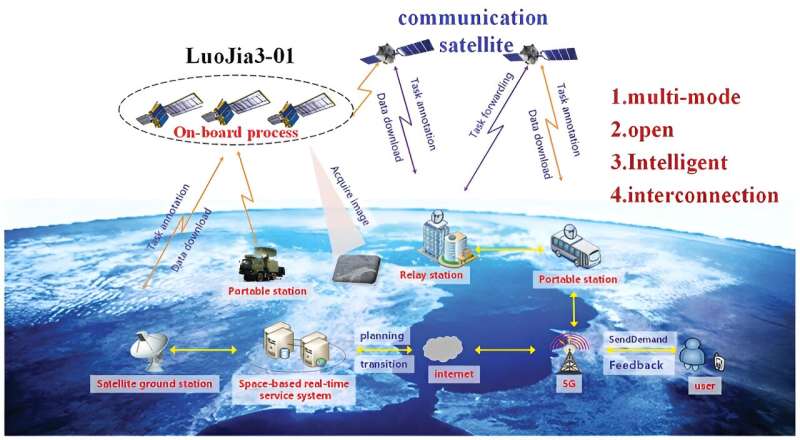
In a research letter published on July 11, 2023, in Geo-spatial Information Science, a research group led by Deren Li and Mi Wang from Wuhan University unveiled the LuoJia3-01, an experimental satellite that integrates state-of-the-art technologies to provide unparalleled geospatial information services. This development is particularly noteworthy in an era dominated by transformative technologies such as 5G, cloud computing, and AI.
The LuoJia3-01 satellite marks a transformative era in remote sensing with its innovative features and methodologies. Equipped with multi-mode imaging capabilities, including high-resolution continuous area imaging, real-time video imaging, and multi-angle 3D imaging, it offers versatile applications ranging from long-term hotspot observation to dynamic target tracking.
A key breakthrough of LuoJia3-01 lies in its on-orbit real-time processing technology system, addressing the challenge of processing massive remote sensing data with delays. This system, encompassing task planning, sensor calibration, target detection, and intelligent compression, ensures efficient data processing in constrained on-board conditions.
Furthermore, the satellite’s interconnectivity feature facilitates seamless communication between the satellite, ground stations, and mobile devices, enabling the swift transmission of processed data to users’ mobile terminals and significantly enhancing remote sensing information accessibility.
The launch of LuoJia3-01 represents a shift in remote sensing satellite services, adopting a B2C model that dramatically shortens the time from data acquisition to delivery at the user’s end. This advancement not only accelerates the efficiency of dynamic emergency responses but also democratizes access to remote sensing data, indicating a significant stride towards “fast, accurate, and intelligent” remote sensing services for the future.
In another study published on July 7, 2023, also in Geo-spatial Information Science, Prof. Deren Li et al from Wuhan University have achieved a significant breakthrough in photogrammetry. Their work on Block Adjustment (BA) methods, vital for the geometric processing of satellite images, has led to revolutionary improvements in the accuracy and efficiency of geospatial data processing.
The study highlights the integration of BA with modern technologies like AI, cloud computing, big data, IoT, and UAVs, transitioning from traditional methods to advanced bundle block adjustments (BBA). This advancement, exemplified in various large-scale applications, marks a pivotal shift in the field, enhancing the capability of BA techniques in handling complex projects and setting a new standard in global mapping and remote sensing.
More information:
Deren Li et al, Internet intelligent remote sensing scientific experimental satellite LuoJia3-01, Geo-spatial Information Science (2023). DOI: 10.1080/10095020.2023.2208472
Deren Li et al, Large-scale automatic block adjustment from satellite to indoor photogrammetry, Geo-spatial Information Science (2023). DOI: 10.1080/10095020.2023.2224837
Citation:
Research explores experimental satellite for internet intelligent remote sensing (2023, November 30)
retrieved 5 December 2023
from https://techxplore.com/news/2023-11-explores-experimental-satellite-internet-intelligent.html
This document is subject to copyright. Apart from any fair dealing for the purpose of private study or research, no
part may be reproduced without the written permission. The content is provided for information purposes only.
Stay connected with us on social media platform for instant update click here to join our Twitter, & Facebook
We are now on Telegram. Click here to join our channel (@TechiUpdate) and stay updated with the latest Technology headlines.
For all the latest Technology News Click Here
For the latest news and updates, follow us on Google News.
